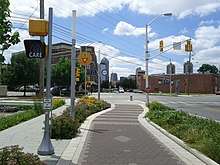Indianapolis Cultural Trail: A Legacy of Gene & Marilyn Glick
The Indianapolis Cultural Trail: A Legacy of Gene and Marilyn Glick is an 8.1-mile-long (13.0 km) urban multi-use trail and linear park located in central Indianapolis, Indiana. The trail has inspired similar projects in U.S. cities such as Charlotte, Cleveland, Denver, and St. Louis.[1][2][3][4]
 | |
| Abbreviation | ICT |
|---|---|
| Formation | April 2007—May 2013 |
| Legal status | non-profit |
| Purpose | urban linear park; multi-use trail |
| Headquarters | 132 West Walnut Street |
| Location | |
| Coordinates | 39°46′36.7″N 86°09′39.4″W |
Executive Director | Kären Haley |
Main organ | Indianapolis Cultural Trail, Inc. |
| Website | indyculturaltrail.org |
Description
The Indianapolis Cultural Trail is a multi-use trail[5][6][7]
Route

Glick Peace Walk
The walk can be accessed at West Walnut Street between North Meridian Street and North Capitol Avenue.[8][9]
Attractions
Indianapolis has seven designated neighborhoods as Cultural Districts, first established in 1999. The purpose of these designations was to capitalize on cultural institutions within historically significant neighborhoods unique to the city's heritage for economic development and revitalization. Six of the seven districts are located along the Cultural Trail.[10]
- Fountain Square
- Indiana Avenue
- Market East
- Massachusetts Avenue
- Canal and White River State Park
- Wholesale District
The seventh district, Broad Ripple Village (about 6.5 miles (10.5 km) north), is connected to the Cultural Trail via the Monon Trail.
Public art

As of 2019, there are nine commissioned art installations along the trail:[8]
- Ann Dancing (Julian Opie)
- Care/Don’t Care (Jamie Pawlus)
- Chatham Passage (Sean Derry)
- Looking Through Windows (Michael Kuschnir)
- Moving Forward (Donna Sink)
- Poet’s Place
- Prairie Modules 1 & 2 (M12)
- Swarm Street (Acconci Studio)
- Talking Wall (Bernard Williams)
In addition to commissioned art, the Arts Council of Indianapolis's "Indy Arts Guide" lists 61 pieces of public art along or near the trail as of January 2019.[11] In August 2018, Citizens Energy Group partnered with the Harrison Center for the Arts to install 20 artist-designed manhole covers along the trail.[12] The initiative sought to bring public attention to Indianapolis waterways and the $1.9 billion DigIndy project to correct the city's combined sewer overflows (CSOs) by 2025.[13]
Indiana Pacers Bikeshare
Impact
According to the Indianapolis Business Journal, early grant applications predicted $863 million in development generated within a 0.5 miles (0.80 km) radius of the trail.[6]
An Indiana University Public Policy Institute report released in March 2015 found that assessed value of properties within 500 feet (150 m) of the trail increased by $1,013,544,460 from 2008 to 2014. Other key finds from the report:[15][16]
- Trail usage along the trail exceeds that of most the other Indianapolis trails and greenways
- Users feel safe on the trail
- Exercise and recreation is the primary reason for use
- Businesses located on the trail have hired additional employees
- Property values have increased along and near the trail
- Users reported spending and economic impact tied to trail usage
References
- Harrison, Steve (February 18, 2018). "Charlotte wants to make SouthPark safer for walkers, bikers". The Charlotte Observer. Retrieved August 26, 2019.
- Litt, Steven (October 19, 2015). "Lorain Avenue Bikeway concept gets a big boost from Cleveland planning commission (photos)". The Plain Dealer. Retrieved August 26, 2019.
- Litt, Steven (August 21, 2019). "5280 Trail aims to be Denver'sanswer to New York City's High Line". The Denver Post. Retrieved August 26, 2019.
- Bryant, Tim (January 23, 2019). "Chouteau Greenway project aims to knit St. Louis neighborhoods together – north, south, east and west". St. Louis Post-Dispatch. Retrieved August 26, 2019.
- "Indianapolis Cultural Trail in Indiana | TrailLink". www.traillink.com. Retrieved November 29, 2018.
- Harry, Lou (May 4, 2013). "Defining the Indianapolis Cultural Trail". Indianapolis Business Journal. Retrieved January 6, 2019.
- "About Indiana Pacer Bikshare". Indianapolis Cultural Trail, Inc. Retrieved January 6, 2019.
- Foxio. "Indianapolis Cultural Trail". Indianapolis Cultural Trail. Retrieved November 29, 2018.
- "Glick Peace Walk Walnut St. between Meridian St. and Capitol Ave. Indianapolis, IN Trail - MapQuest". www.mapquest.com. Retrieved November 29, 2018.
- "Downtown Indy Cultural Districts". DowntownIndy. Retrieved November 29, 2018.
- "Indy Arts Guide". Indianapolis Arts Council. Retrieved January 5, 2019.
- Bahr, Sarah (July 24, 2018). "These 20 manhole covers will catch your eye on the Cultural Trail". The Indianapolis Star. Retrieved December 5, 2018.
- Stall, Sam (July 11, 2015). "Go behind the scenes of Indy's $1.9B sewer overhaul". Indianapolis Business Journal. Retrieved April 25, 2016.
- Simmons, Andrew (March 4, 2014). "In Indianapolis, a Bike Path to Progress". The New York Times. Retrieved January 6, 2019.
- Burow, Sue; Majors, Jessica (March 2015). "Assessment of the Impact of the Indianapolis Cultural Trail: A Legacy of Gene and Marilyn Glick" (PDF). Indiana University Public Policy Institute. Retrieved January 5, 2019.
- Burow, Sue; Majors, Jessica (2015). "Reasons to Love the Indianapolis Cultural Trail: A Legacy of Gene and Marilyn Glick" (PDF). Indiana University Public Policy Institute. Retrieved January 5, 2019.
External links
- Official website
- Streetfilms "The Indianapolis Cultural Trail: The Next-Gen in U.S. Protected Bike Lanes"
| Wikimedia Commons has media related to Indianapolis Cultural Trail. |
